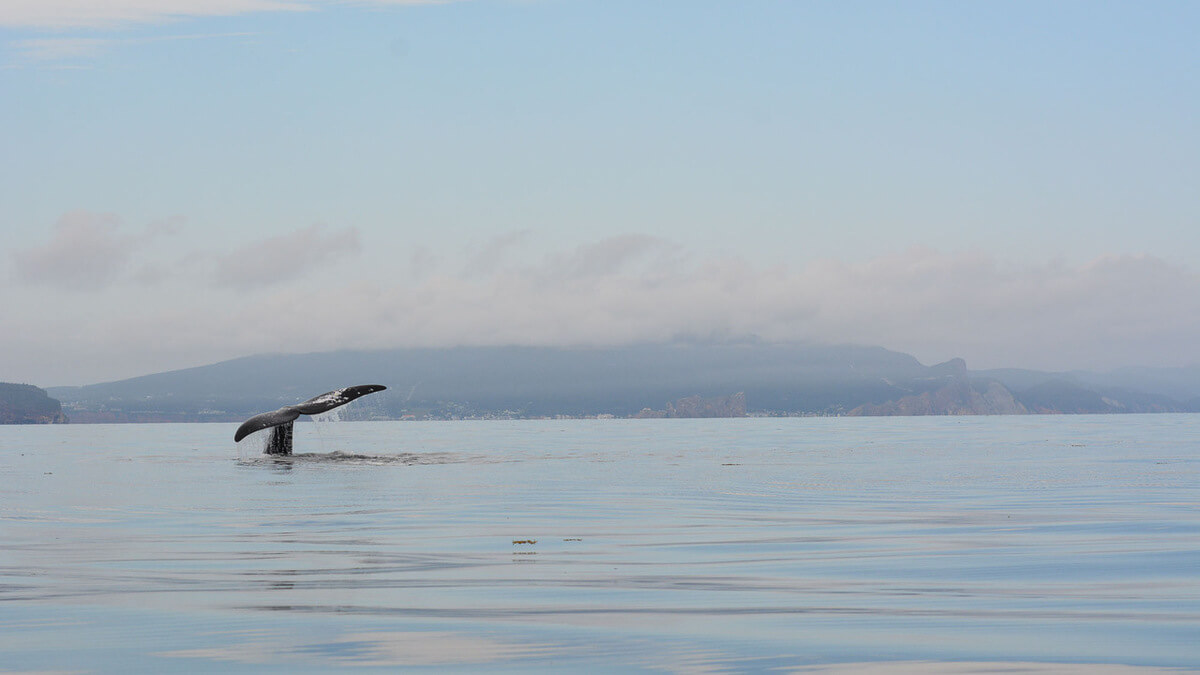While some communities are eagerly waiting for the ice to break up on the local river or for the tulips to bloom, in the Haute-Côte-Nord region, it’s the return of a very special whale that’s become the talk of the town. On Thursday, May 11, the humpback whale Tic Tac Toe was observed for the first time this year in the Saguenay-St. Lawrence Marine Park!
Amongst humpbacks, Tic Tac Toe is a star. Probably one of the best-known whales in the St. Lawrence, this female has it all: she is easily identifiable, she’s been making incursions into the estuary almost annually since 1999 and she regularly shows her tail. It was from Cap de Bon-Désir in Les Bergeronnes that our collaborator Renaud Pintiaux was able to spot her on May 11.
After being accompanied by young individuals in 2020, 2021 and 2022, this time she showed up alone. Some folks have even wondered if she might have had three calves in three years, which, while possible, would be rather remarkable. Only genetic testing of the individuals observed with her would be able to shed light on this mystery.
In the days preceding the Tic Tac Toe sighting, humpbacks had also been seen from the dunes in Tadoussac. On May 6, a large blast erupts between the wind and the waves, blurring the horizon, but it’s impossible to identify the species. The next day, the backs and breaths of three humpback whales are visible.
A minke whale, harbour seals, belugas and harbour porpoises were also reported between Tadoussac and Les Bergeronnes over the past week.
The joys of boating and the water’s edge
During an excursion between Notre-Dame-du-Portage and Île Le Gros Pèlerin, a kayaker had the opportunity to admire some marine fauna. “Near the eastern tip of the island, we’ve been hearing birds and seal pups like I’ve never heard before,” he says. I resisted the urge to approach, settling instead with good looks through my binoculars.” Indeed, this is a good habit to adopt!
With the return of warmer weather and boating activities, the presence of marine mammals should be taken into account when passing through their habitat. To learn more about this subject and how to avoid disturbing the whales or seals that you encounter, you can complete a free training that takes about 40 minutes.
In Gaspé Bay, a hiker had the opportunity to observe a haulout of about sixty harbour seals basking in the sun. The next day, while out for another stroll, she spotted four seals on the beach.
On the other side of the river, two minke whales were reported from Sept-Îles and Port-Cartier. Between Pointe-des-Monts and Godbout, three humpbacks mark the start of the summer season for local residents. From the shore, through their binoculars or standing on their paddle boards, two friends enjoyed many encounters during their ramblings along the coast. “My friend and I saw a blue whale, a fin whale and a humpback on Saturday, May 6.”
In Franquelin, a herd of about 30 seals was seen heading east on May 6. Some of them were showing large parts of their bodies when swimming, explains the observer, wondering if they might be harp seals. “Then, against a magical evening backdrop, a fantastic, unexpected and surreal scene took place,” she says. “At first I thought I had spotted porpoises… but when I looked a little closer, I saw that their dorsal fins were much larger and pointier than those of porpoises. I grabbed my binoculars and could see pink and yellow tints on the otherwise white flanks! Here there was a herd of about twenty dolphins, changing direction a few times for about fifteen minutes before resuming their journey toward the southwest. Lastly, two humpbacks were also present.”
Sightings of large numbers of belugas have also been reported throughout the estuary: at the mouth of the Saguenay, near Île aux Lièvres , from Cacouna, from Cap-à-l’Aigle in La Malbaie, from the shores of Saint-Irénée…
[DA1]Coquille VF : ça prend une L majuscule ici
Right whales in the gulf
North Atlantic right whales are quietly returning from their migration. On May 7, a Fisheries and Oceans Canada surveillance plane reported two individuals, a first of the year for this species in Canadian waters. Thanks to a series of protective measures, the area where the whales were observed will be off limits to fishing for 15 days and slowdown measures will be implemented for any vessels transiting the sector. With fewer than 340 individuals remaining, this species is affected by entanglements in fishing gear, ship strikes and climate change.








